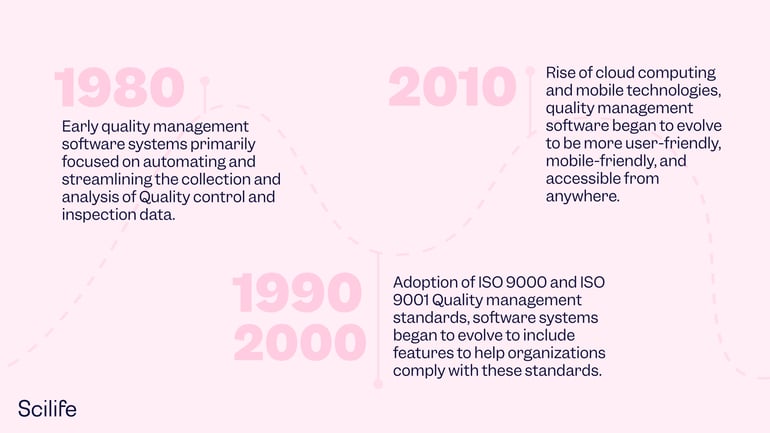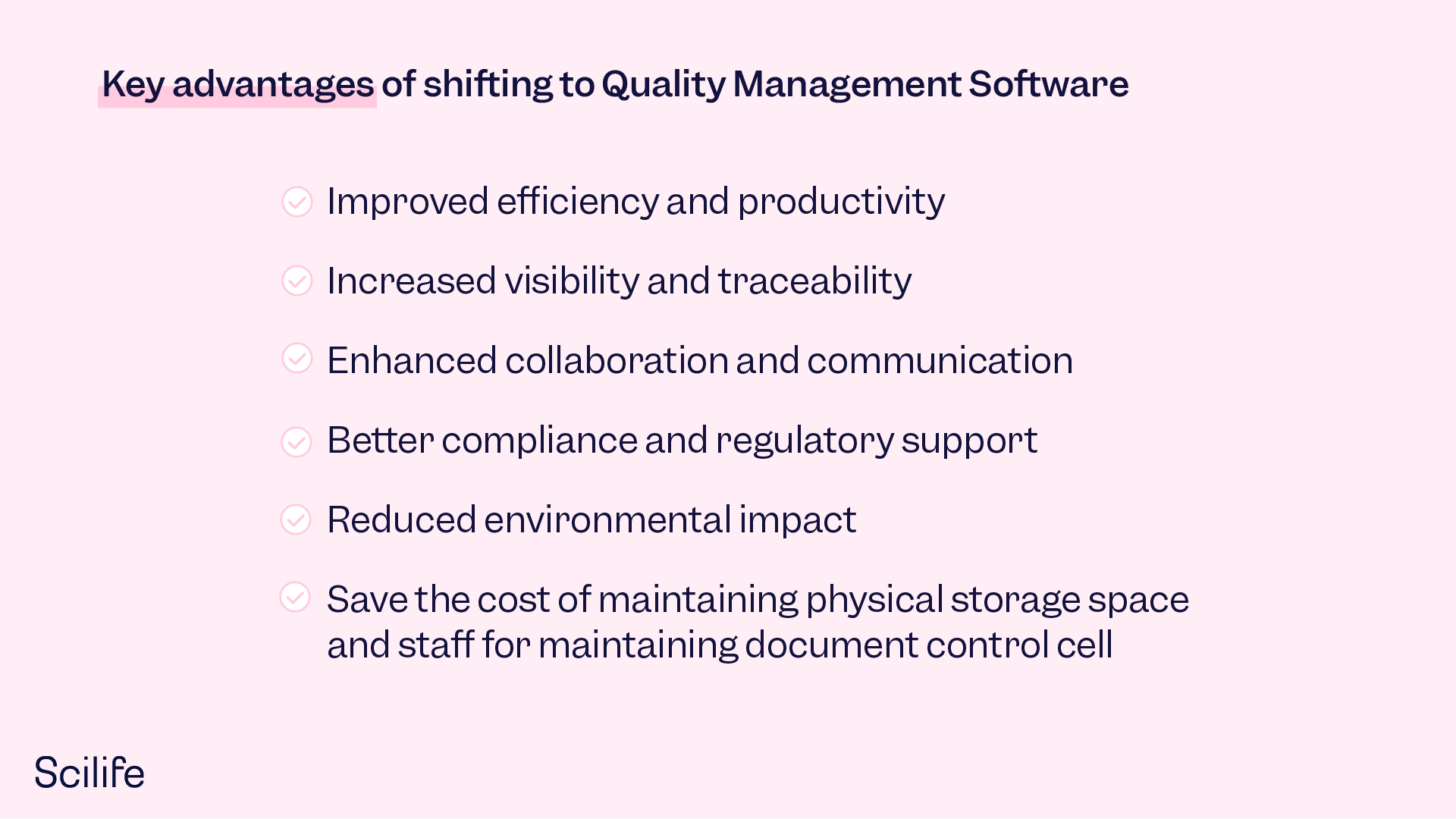Quality Management Software
Quality management software (QMS) is a computerized system that manages and maintains an organization's Quality processes. It is designed to help organizations streamline their Quality management processes, such as document control, non-conformance management, change control management, corrective and preventive actions, and training management.
History of Quality Management Software
The history of quality management software can be traced back to the late 20th century, with the rise of computer technology and automation in the manufacturing and business industries.
In the 1980s, early quality management software systems primarily focused on automating and streamlining the collection and analysis of Quality control and inspection data. These systems were typically used in manufacturing and production environments and focused on tasks such as statistical process control and data analysis.
In the 1990s and 2000s, with the increasing adoption of ISO 9000 and ISO 9001 Quality management standards, software systems began to evolve to include features to help organizations comply with these standards. These systems often included modules for document control, corrective and preventive action, and internal auditing.
In the 2010s, with the rise of cloud computing and mobile technologies, quality management software began to evolve to be more user-friendly, mobile-friendly, and accessible from anywhere. Additionally, these systems often include advanced analytics, reporting, and visualization tools to help organizations gain insight into their Quality performance.
Nowadays, Quality Management Software has evolved to include more advanced features such as real-time data collection, automated workflow, and integration with other enterprise software like ERP and CRM.

Quality Management Software as a tool for Digital Transformation
Quality Management Software is becoming an integrated part of digital transformation in many organizations. It is used not only for compliance and Quality control but also to improve efficiency, reduce costs, and increase customer satisfaction. It is an excellent digital transformation tool for organizations that plan to go paperless.
Advantages of Quality Management Software Over Paper-Based Quality Management System
Quality management is essential to the Life Science industry and ensuring that products and services meet or exceed customer expectations is vital to success. However, traditional paper-based Quality management systems can be time-consuming, inefficient, and prone to errors. Therefore, Life Science industries are increasingly embracing Quality Management Software that has several advantages over paper-based Quality management systems. Some of the key advantages of shifting to Quality Management Software from a paper-based Quality Management System include the following:

- Improved efficiency and productivity:
- Automated processes and electronic document management can save time and reduce errors.
- For example, automatic linking of related documents, CAPAs, events, change controls, etc., can save time on linking related documents manually.
- It allows organizations to focus on more important tasks. For example, a QMS can automatically route documents for review and approval, reducing the need for manual tracking and follow-up.
- Increased visibility and traceability:
- Electronic records and data analysis tools provide real-time visibility into Quality performance, enabling organizations to identify and address issues more quickly.
- This can help organizations proactively identify and address potential Quality problems before they occur, reducing the risk of product defects and customer complaints.
- Audit trails capture extensive details of every change in the Quality management records.
- The audit trail can act as a centralized, auditable record of all Quality-related activities, which can be used to demonstrate compliance with industry regulations and standards.
- Enhanced collaboration and communication:
- QMS allows multiple users to access and update information simultaneously, improving team collaboration and communication.
- Users can leave suggestions for each other to improve the Quality management processes they are working on.
- This can help organizations make faster and more informed decisions, and can improve the overall efficiency and effectiveness of Quality management activities.
- Better compliance and regulatory support:
- QMS can help organizations meet industry regulations and standards by providing a centralized, auditable record of all Quality-related activities.
- It is a crucial advantage for Life Science companies as Life Science companies need to meet several regulatory requirements, including but not limited to 21 CFR Part 11, 21 CFR Part 280, EU MDR, EU MDD, GAMP5, ISO 13485:2016, and ISO 9001:2005.
- Quality Management Software for Life Science companies should be ideally compliant with all the necessary regulations so that the manufacturers spend less time and effort managing the compliance requirements.
- Reduced environmental impact:
- Since the paperless system eliminates the use of paper, it saves trees.
- Additionally, it also helps reduce waste and carbon footprint.
- Additionally, Quality Management System can save the cost of maintaining physical storage space and staff for maintaining document control cell.
In summary, Quality Management Software is a powerful tool that can help organizations streamline their Quality management procedures and improve overall Quality performance. With automation, real-time visibility, and improved collaboration and communication, QMS can help organizations make faster and more informed decisions and ultimately improve customer satisfaction. While paper-based systems may have been sufficient in the past, today's fast-paced business environment requires a more efficient and effective approach to Quality management, and Quality Management Software is the solution.
Additional resources

How to Implement the Continuous Improvement Cycle | Scilife
Even an organization with stellar leadership and a solid core of employees experiences hiccups from time to time. Despite having assembled all the ...

How to assess and enhance your Quality Management Maturity | Scilife
As the life sciences industry becomes increasingly regulated and competitive, quality management has become more vital than ever. Are you confident ...

Best Quality Management Software (QMS) for Life Sciences | Scilife
The right electronic Quality Management System (eQMS) can help strengthen your compliance processes and build a culture of quality within your ...

How to write a good quality plan for medical devices | Scilife
In life sciences, especially if you’re in the medical device industry it becomes harder to manage projects in accordance with your company’s quality ...
Turn quality into your brightest asset with Scilife
